
How Much Should Be in Your Emergency Fund?
Current inflation is enough to make almost anyone worry about having the right amount of money set aside in case of an emergency. Americans – and people around the world – have certainly come to understand how quickly financial tides can turn and the necessity of saving for unexpected expenses.
A new survey of 1,025 U.S. adults from Bankrate found that more than half – some 58% – reported being concerned about the amount they have in emergency savings. That figure is up a whopping 10 percent from 48 percent in 2021 (and 44 percent in 2020). To help ease the sting of inflation, many people are dipping into savings (that were bulked up during the height of the Covid pandemic) to pay for the rising cost of food, rent, and more.
The great thing about emergency funds is that even if you deplete them, you can begin to build them back up again as soon as you are able. You should make it as easy on yourself as possible by setting up an electronic withdrawal either with your employer or with your financial institution so that money is moved to savings every week or month (from a checking account) without you having to take the extra steps of remembering and following through. You will be so glad you did!
When it comes to figuring out exactly how much cash you will need to stash in your emergency fund, the answer will vary based on several factors, including your age, if you are single or living with a partner who works outside the home, how many people depend on your income, and how close you are to retiring.
If you are a one-income household
Those who work to support a family without the cushion of an extra income likely need more savings to cover basic living expenses if something happens to the sole income provider. This is when it’s necessary to have a solid six months of money set aside in a separate account to pay for the basics.
If there are two or more earners at home
You can ease up just a little on how much you’ll need to have saved when there are multiple earners supporting a household. Start with the amount you will need to pay for three to six months of expenses. If one person loses their job or is unable to work for a while, the other earners’ paychecks can supplement savings to help you make it through the rough patch.
If you are single (and early or mid-career)
Someone who is single also should aim to have three to six months of money set aside in an account in case they lose their job or have another emergency that requires extra money. Remember, this amount should cover rent, utilities, food, and other necessities, not necessarily extras such as streaming services, or other things you can live without when money is tight.
If you are two years or less from retirement age
People who find themselves in this situation should probably have a goal of gathering the money to be able to pay for a year or more of living expenses to bridge the gap to retirement and the ability to collect Social Security benefits. The older you are, the more expensive life can become, often with more medical expenses and higher premiums for insurance and other protections.
Fortera offers many Savings account options designed to keep your money safe and growing. From Money Market accounts and certificates to traditional savings accounts, we have an option to meet your goals.
Article distributed in partnership with SavvyMoney with reporting by Jean Chatzky and Casandra Andrews